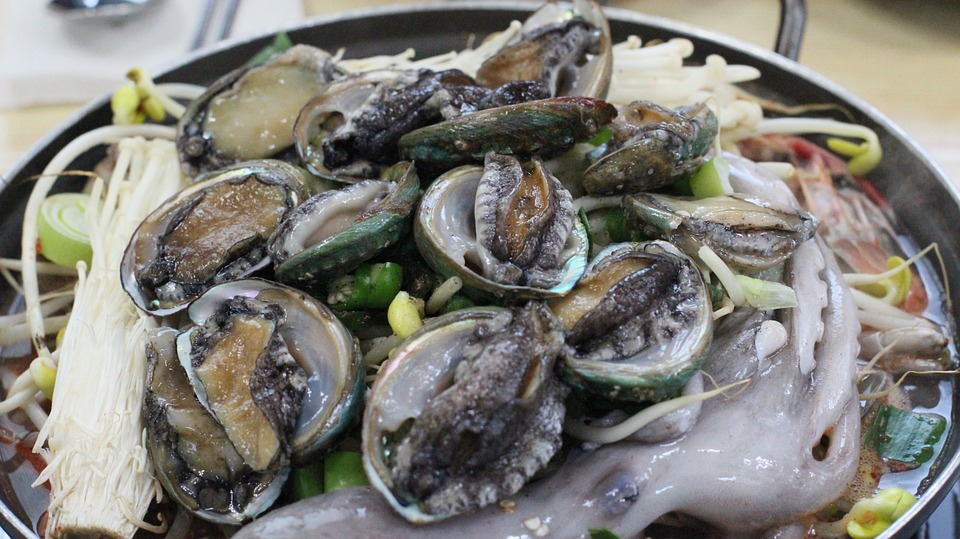World abalone production at high levels, yet prices remain steady

Known in ancient times as the “elixir of life” and as the “emperor of shellfish”, today abalone upholds its place as one of the most expensive of any seafood item worldwide. As with other seafood, production has shifted from wild caught to farmed, and today over 95 percent of abalone comes from aquaculture. In 2015, capture fisheries landed less than 7 000 tonnes of the species, a decline of 70 percent since 1950. In contrast, world aquaculture production grew to over 135 000 tonnes in 2014, which was an industry virtually nonexistent 40 years ago.
Asia
China
China is easily the leading producer of abalone in the world, producing nearly 115 400 tonnes in 2014,and remains the foremost consuming country. China is also a substantial importer. A fourfold increase (400 percent) in production over the past 10 years has allowed millions of more Chinese consumers to enjoy this expensive yet favorite delicacy. Average market prices in mid-2016 US$25–27 per kg, in shell.
Republic of Korea
With virtually no production 15 years ago, the Republic of Korea has become the second largest worldwide producer at over 9 000 tonnes in 2014. Predominately grown on small-scale farms, many issues are currently under national study, including increasing exports, improving the processing/distribution system, and imbalances in supply.
Japan
After Hong Kong SAR, Japan is the world’s second largest and most discerning importer of abalone, with fish markets displaying abalone from virtually every producing country. In 2014, Japan produced 1 360 tonnes and imported over 2 600 tonnes as well. Prices are steady, with the country’s own landings receiving a premium over all imports.
The Pacific
Australia
Australia is the world’s largest remaining capture abalone fishery. In 2014, Australia produced nearly 5 000 tonnes, which includes almost 900 tonnes from their growing aquaculture industry. Exports in 2015 totaled 2 680 tonnes. It is hoped that the recent China-Australia free-trade agreement will result in greater access to the Chinese markets.
New Zealand
Government quotas have perpetuated commercial abalone landings at 800 to 1 000 tonnes for the past 10 years. Unfortunately, IUU fishing remains substantial. New Zealand maintains a small but growing aquaculture industry.
Africa
South Africa
Once a major capture exporter, the fishery has been virtually closed for many years, primarily due to continuing IUU activities. Beginning in the early 1990s, an infant aquaculture industry has grown exponentially, exporting 1 130 tonnes in 2015. South Africa’s abalone is considered one of the world’s most premium, in part the result of strong quality control as well as the fact that it is of a larger size and has a unique taste that is preferred by many.
North, South, Central America
Mexico
Mexican-captured abalone is considered a world premium. This is because Mexico is one of the last countries to legally fish wild, large-sized, green abalone (H. fulgens) under a government quotas system. The bulk is processed into cans of 255 g drained weight, with price per can the highest of any canned abalone in the world. Government fishing quotas have been reduced nearly 30 percent from 2010 to 2015, in part as a result of unabated cartel-related IUU activity. Mexico has a small yet growing aquaculture industry.
Chile
In contrast to other countries, abalone is not indigenous to Chile but Chileans were introduced to the taste of abalone with product from California. Chile began farming red abalone (H. rufescens) in the early 1990’s, with production achieving 1 200 tonnes in 2014.
USA
Once one of the world’s largest abalone fisheries, overfishing and IUU activity led to a total commercial closure 20 years ago. Abalone is currently farmed only in California and Hawaii, with a large percentage exported live to Asia, notwithstanding a growing US market.
Other countries
In addition to the higher production countries, commercial aquaculture also exists in Canada, Channel Islands, France, Iceland, Ireland, Italy, Namibia, New Zealand, Oman, Spain, Taiwan Province of China, Thailand and the UK. There is also a capture fishery in the Philippines.
The report analyses the market situation over the period January-October 2016

